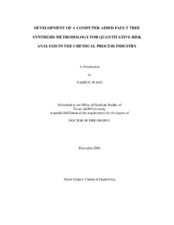| dc.contributor.advisor | Mannan, M. Sam | |
| dc.creator | Wang, Yanjun | |
| dc.date.accessioned | 2005-02-17T20:59:21Z | |
| dc.date.available | 2005-02-17T20:59:21Z | |
| dc.date.created | 2004-12 | |
| dc.date.issued | 2005-02-17 | |
| dc.identifier.uri | https://hdl.handle.net/1969.1/1347 | |
| dc.description.abstract | There has been growing public concern regarding the threat to people and
environment from industrial activities, thus more rigorous regulations. The investigation
of almost all the major accidents shows that we could have avoided those tragedies with
effective risk analysis and safety management programs. High-quality risk analysis is
absolutely necessary for sustainable development.
As a powerful and systematic tool, fault tree analysis (FTA) has been adapted to
the particular need of chemical process quantitative risk analysis (CPQRA) and found
great applications. However, the application of FTA in the chemical process industry
(CPI) is limited. One major barrier is the manual synthesis of fault trees. It requires a
thorough understanding of the process and is vulnerable to individual subjectivity. The
quality of FTA can be highly subjective and variable.
The availability of a computer-based FTA methodology will greatly benefit the
CPI. The primary objective of this research is to develop a computer-aided fault tree
synthesis methodology for CPQRA. The central idea is to capture the cause-and-effect
logic around each item of equipment directly into mini fault trees. Special fault tree
models have been developed to manage special features. Fault trees created by this
method are expected to be concise. A prototype computer program is provided to
illustrate the methodology. Ideally, FTA can be standardized through a computer
package that reads information contained in process block diagrams and provides
automatic aids to assist engineers in generating and analyzing fault trees.
Another important issue with regard to QRA is the large uncertainty associated
with available failure rate data. In the CPI, the ranges of failure rates observed could be
quite wide. Traditional reliability studies using point values of failure rates may result in
misleading conclusions. This dissertation discusses the uncertainty with failure rate data
and proposes a procedure to deal with data uncertainty in determining safety integrity
level (SIL) for a safety instrumented system (SIS). Efforts must be carried out to obtain
more accurate values of those data that might actually impact the estimation of SIL. This
procedure guides process hazard analysts toward a more accurate SIL estimation and
avoids misleading results due to data uncertainty. | en |
| dc.format.extent | 2273972 bytes | en |
| dc.format.medium | electronic | en |
| dc.format.mimetype | application/pdf | |
| dc.language.iso | en_US | |
| dc.publisher | Texas A&M University | |
| dc.subject | quantitative risk analysis | en |
| dc.subject | fault tree analysis | en |
| dc.subject | fault tree synthesis | en |
| dc.subject | computer-aided fault tree synthesis | en |
| dc.title | Development of a computer-aided fault tree synthesis methodology for quantitative risk analysis in the chemical process industry | en |
| dc.type | Book | en |
| dc.type | Thesis | en |
| thesis.degree.department | Chemical Engineering | en |
| thesis.degree.discipline | Chemical Engineering | en |
| thesis.degree.grantor | Texas A&M University | en |
| thesis.degree.name | Doctor of Philosophy | en |
| thesis.degree.level | Doctoral | en |
| dc.contributor.committeeMember | West, Harry H. | |
| dc.contributor.committeeMember | Chen, Jianer | |
| dc.contributor.committeeMember | Teague, Tom L. | |
| dc.type.genre | Electronic Dissertation | en |
| dc.type.material | text | en |
| dc.format.digitalOrigin | born digital | en |


